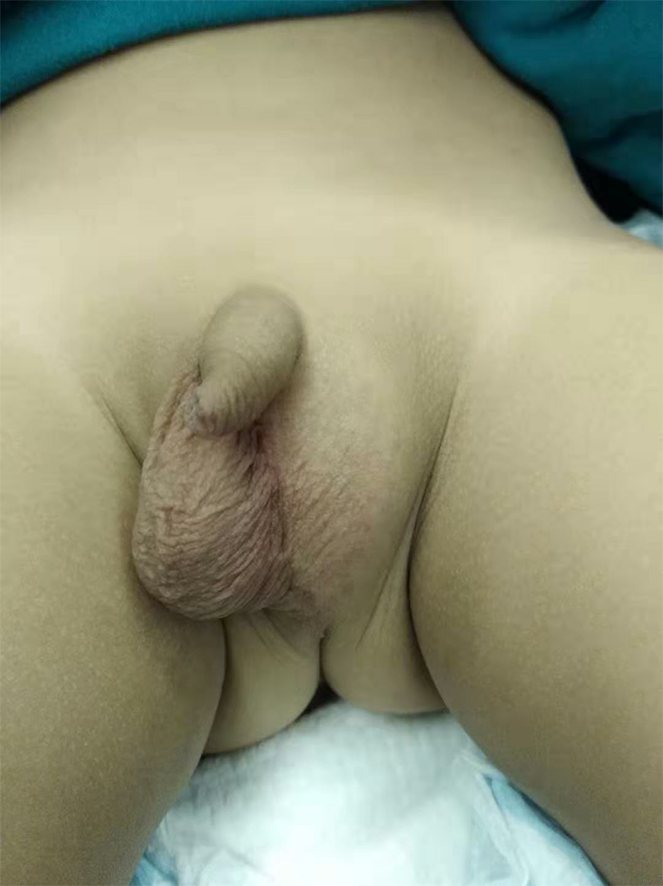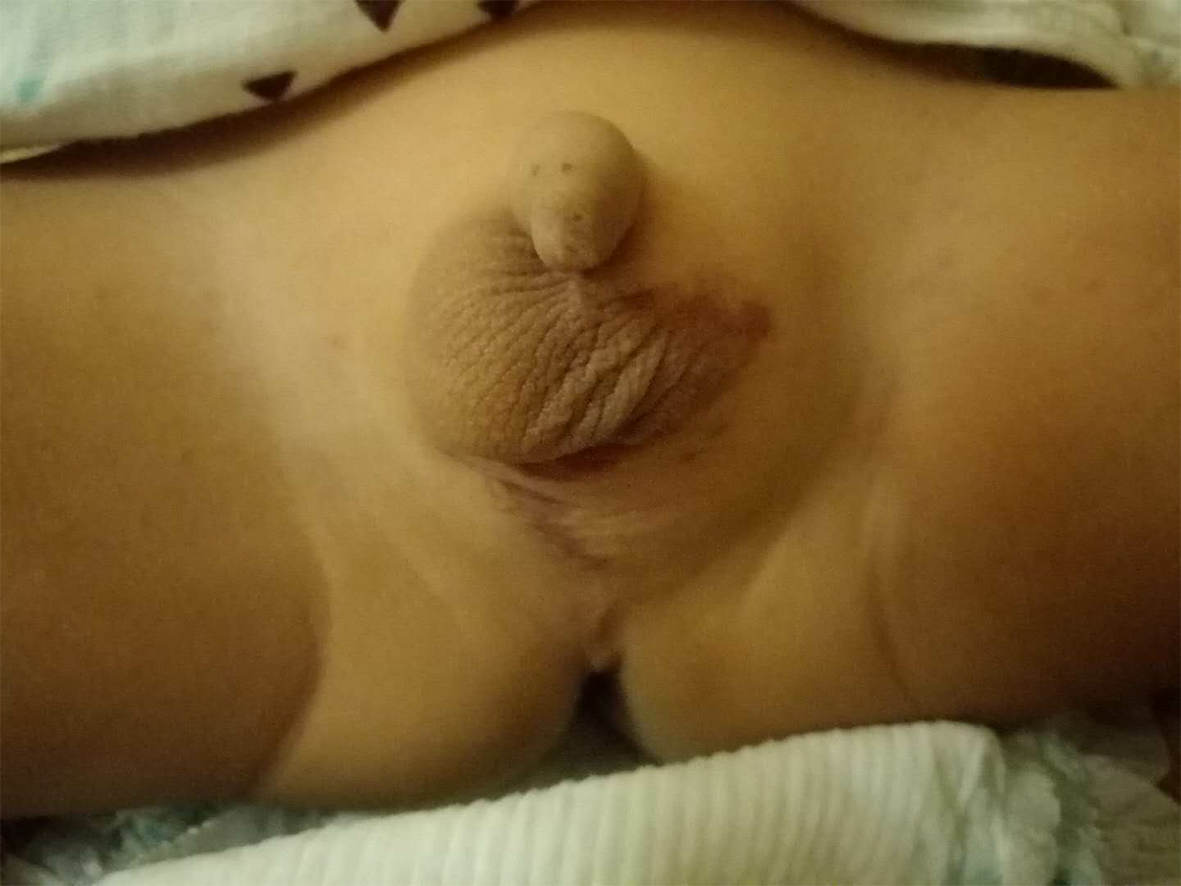Published online Nov 26, 2019. doi: 10.12998/wjcc.v7.i22.3807
Peer-review started: July 27, 2019
First decision: September 9, 2019
Revised: September 19, 2019
Accepted: September 25, 2019
Article in press: September 25, 2019
Published online: November 26, 2019
Processing time: 122 Days and 3.7 Hours
Congenital scrotal agenesis (CSA) is very rare. There are 11 cases of congenital scrotal agenesis or absence reported in the literature, most of which are bilateral and accompanied by cryptorchidism. Only two cases of which are unilateral scrotal agenesis and not accompanied by cryptorchidism. This is the first reported case of unilateral scrotal agenesis with cryptorchidism and scrotoplasty.
A 2-year-old boy was admitted to our hospital with left cryptorchidism and ipsilateral CSA. An innovative method was used in the patient where a scrotal skin pedicle from the right part of scrotal skin was transplanted to the left side. At the same time, descent orchiopexy was performed. At the 4-mo follow-up, the left testicle was located in the scrotum and the size and shape were normal.
For unilateral CSA with ipsilateral cryptorchidism, contralateral scrotal pedicle transplantation and descent orchiopexy appear to be a successful surgical option.
Core tip: Congenital scrotal agenesis is very uncommon. More specially, this is the first reported case of unilateral scrotal agenesis with cryptorchidism. We innovatively transplanted the contralateral scrotal skin flap to the affected side and achieved satisfactory results.
- Citation: Fang Y, Lin J, Wang WW, Qiu J, Xie Y, Sang LP, Mo JC, Luo JH, Wei JH. Unilateral congenital scrotal agenesis with ipsilateral cryptorchidism: A case report. World J Clin Cases 2019; 7(22): 3807-3811
- URL: https://www.wjgnet.com/2307-8960/full/v7/i22/3807.htm
- DOI: https://dx.doi.org/10.12998/wjcc.v7.i22.3807
Cryptorchidism is a common disease in children, but congenital scrotal agenesis (CSA) is very rare. At present, there are 11 cases of CSA reported in the literature[1-5]. Two of these cases are unilateral, while the rest are bilateral, most of which are accompanied by cryptorchidism. Recently, a boy with left cryptorchidism and ipsilateral congenital scrotal agenesis was treated in our hospital. Our innovative method involved performing descent orchiopexy and then transplanting a scrotal skin pedicle from the right part of scrotal skin to the left side. Through this method, we were able to achieve satisfactory results, as detailed in this report.
The patient was a 2-year-old boy born with abnormal skin of the left scrotum. It was later found that the left testicle was not in the scrotum.
When the patient was 2 years old, he went to the local hospital for descent orchiopexy. However, after the doctors discovered skin agenesis of his scrotum, he was transferred to our hospital for treatment because this disease had never been seen in their hospital and local physicians were worried about the effect of surgical treatment.
The patient’s parents denied any past surgical interventions.
The patient was born in normal childbirth and his parents were healthy.
The left testicle was located in the inguinal region and was about 1.2 cm × 1 cm in size. The right testicle and scrotum developed normally, however, the skin of the left scrotum was significantly less wrinkled and was pale compared to the right side (Figure 1).
The karyotype was normal (46XY), and high-throughput sequencing results indicated that the child carried the SRY gene without any pathogenic variations of sex development disorder genes (WNT4, NR5A1, SOX9, and NROB1).
Ultrasonography determined that there were no abnormalities in the kidneys, bladder, or prostate; the left testicle was located in the inguinal region, which was 1.2 cm × 1 cm in size; the right testicle was located in the right scrotum, which was 1.5 cm × 1.2 cm in size.
Unilateral CSA with ipsilateral cryptorchidism.
Treatment at our hospital occurred in February 2019. First, we recovered the testis by making an incision in the left lower abdomen and freed the testis from the surrounding tissue until it would be able to descend to the scrotum and ligate the unclosed sheath process at a high position. Then we cut a pedicle of skin tissue from the right scrotum (size of pedicle = 2 cm × 2 cm), cut open the left agenesis scrotum skin (3 cm), placed the left testis into the incision, and fixed the testis with cotton balls. Lastly, the pedicled scrotal skin was sewed into the incision (Figure 2).
Follow-up at 4 mo after the surgery showed that there were no complications and the wound had healed well. The left testicle was located in the scrotum and the size and shape were normal (Figure 3).
CSA or congenital scrotal absence is a very rare disease and most of the time occurs in a bilateral manner. According to the available literature, there are two cases of unilateral scrotal agenesis without cryptorchidism[1,2]. This is the first reported case of unilateral scrotal agenesis with cryptorchidism and scrotoplasty. The pathogenesis of scrotal agenesis is not clear. The patient in this study carries SRY gene and we did not detect pathogenic variations of related sex development genes. There was no androgen insensitivity or 5-reductase deficiency overall, but local androgen insensitivity or 5-reductase deficiency specifically in the scrotum may exist. There is a hypothesis that descending testicles contribute to the formation of scrotal skin, but one case of unilateral scrotal agenesis did have normal testicles[1], so this hypothesis may not be valid. Additionally, previous reports have shown that complete scrotal agenesis patients can carry heterozygous genomic variation in exon 17 of the MAP3K1 gene[3], suggesting that this mutation may play a role in the pathogenesis of scrotal agenesis.
Therapeutic measures for CSA or congenital scrotal absence mainly include drug treatment, surgical treatment, and regular observation. Mohan et al[4] reported two cases of scrotal agenesis treated with testosterone and found that the scrotum gradually developed into skin wrinkles. Currently, operation options include prepuce flap transplantation; testicular descent and fixation after testicular prostheses expanding the skin[3,5]. Some patients also chose not to undergo surgery and instead opt for regular observation as their preferred course of action[1]. Although the prepuce skin and scrotal skin were used almost interchangeable for a long time[6], for this patient, we did not use prepuce transplantation because of the postoperative risk of small area necrosis and infection in prepuce transplantation flaps[5]. Additionally, the appearance of scrotal skin is quite different from prepuce skin, so a scrotal skin pedicle was the preferred option. There are also other several reasons to consider scrotal skin transplantation. First, the nearby pedicled skin flap is more likely to survive after transplantation. Second, compared with prepuce skin and dilated perineal skin, scrotal skin wrinkles are more conducive to testicular heat dissipation, allowing the pedicled scrotal skin to serve a functional purpose. Finally, a scrotal skin graft is closer to the shape of the natural scrotum and may positively contribute to his psychological stability in adulthood.
In summary, contralateral scrotal pedicle transplantation and descent orchiopexy are a feasible surgical method for unilateral CSA with ipsilateral cryptorchidism. Compare with other surgical methods, it is more conducive to retain the inherent function of scrotal skin itself, and will reduce the psychological shadow brought by the disease to the growth of children. But further follow-up is necessary in order to determine its long-term efficacy.
Manuscript source: Unsolicited manuscript
Specialty type: Medicine, Research and Experimental
Country of origin: China
Peer-review report classification
Grade A (Excellent): 0
Grade B (Very good): 0
Grade C (Good): C
Grade D (Fair): 0
Grade E (Poor): 0
P-Reviewer: Salvi PF S-Editor: Zhang L L-Editor: Wang TQ E-Editor: Wu YXJ
| 1. | Flum AS, Chaviano AH, Kaplan WE. Hemiscrotal agenesis: new variation in a rare anomaly. Urology. 2012;79:210-211. [RCA] [PubMed] [DOI] [Full Text] [Cited by in Crossref: 16] [Cited by in RCA: 17] [Article Influence: 1.2] [Reference Citation Analysis (0)] |
| 2. | Yilmaz E, Afşarlar CE, Karaman I, Özgüner IF, Karaman A, Hızli F. Congenital hemiscrotal agenesis: report of a rare entity. J Pediatr Urol. 2013;9:e76-e77. [RCA] [PubMed] [DOI] [Full Text] [Cited by in Crossref: 10] [Cited by in RCA: 9] [Article Influence: 0.8] [Reference Citation Analysis (0)] |
| 3. | Spagnoli A, Borsellino A, Crucianelli S, Bizzarri C, Mucciolo M, Trucchi A, Ferro F. Complete Scrotal Agenesis: New Surgical Approach Using Self-inflating Tissue Expander. Urology. 2018;112:169-171. [RCA] [PubMed] [DOI] [Full Text] [Cited by in Crossref: 1] [Cited by in RCA: 1] [Article Influence: 0.1] [Reference Citation Analysis (0)] |
| 4. | Mohan PP, Woodward MN, Chandran H, Parashar K. Topical testosterone in scrotal agenesis. Pediatr Surg Int. 2006;22:565-566. [RCA] [PubMed] [DOI] [Full Text] [Cited by in Crossref: 16] [Cited by in RCA: 16] [Article Influence: 0.8] [Reference Citation Analysis (0)] |
| 5. | Wright JE. Congenital absence of the scrotum: case report and description of an original technique of construction of a scrotum. J Pediatr Surg. 1993;28:264-266. [RCA] [PubMed] [DOI] [Full Text] [Cited by in Crossref: 21] [Cited by in RCA: 21] [Article Influence: 0.7] [Reference Citation Analysis (0)] |
| 6. | Fam MM, Hanna MK. Resurfacing the Penis of Complex Hypospadias Repair ("Hypospadias Cripples"). J Urol. 2017;197:859-864. [RCA] [PubMed] [DOI] [Full Text] [Cited by in Crossref: 15] [Cited by in RCA: 23] [Article Influence: 2.9] [Reference Citation Analysis (0)] |











